Majorana–Kondo interplay in a Majorana wire-quantum dot system with ferromagnetic contacts*
Fu-Bin Yang (羊富彬)
Department of Physics & Key laboratory of Photonic and Optical Detection in Civil Aviation,Civil Aviation Flight University of China,Guanghan 618307,China
Abstract We consider a single-level quantum dot (QD) and a topological superconducting wire hosting Majorana bound states at its ends.By the equation of motion method,we give the analytical Green's function of the QD in the noninteracting and the infinite interacting case.We study the effects of QD energy level and the spin polarization on the density of states(DOS)and linear conductance of the system.In the noninteracting case,the DOS resonance shifts with the change of energy level and it shows bimodal structure at large spin polarization strength.In the infinite interacting case,the upspin linear conductance first increases and then decreases with the increase of spin polarization strength,but the down-spin is stable.However,the DOS shows a splitting phenomenon in the large energy level with the increase of spin polarization strength.This provides an interesting way to explore the physical properties of such spin dependent effect in the hybrid Majorana QD systems.
Keywords: Majorana system,Kondo effect,spin polarized
Recently,the interplay between the quantum dot (QD) and a topological superconducting wire hosting Majorana bound states (MBSs) is studied in the center of condensed matter physics [1–4].The Majorana fermions are expected to be detected by attaching quantum objects around them.In this consideration,the Majorana zero-energy modes can provide some excited solid-state signatures of the Majorana fermions,which have been reported in a number of experiments[5–10].It has been demonstrated that the detection of MBSs can be performed by measuring the transport current through a QD,which paves the way for more sophisticated experimental realizations of hybrid Majorana QD system.From this perspective,it is necessary to provide further theoretical models and understanding of Majorana QD system,for that the strong Coulomb repulsion in a QD coupled to metallic leads can induce the Kondo problem at low temperature [11,12].For example,a QD coupled to topological quantum wire is fertile to explore the physical properties of hybrid Majorana-QD system [13].Facts have been proved that the existence of Majorana mode leads to unique transmission characteristics,including fractional values of the conductance [14].
Another point is the QD coupled to the topological Majorana wire is abundant to explore the physical properties of the Majorana fermions by measuring the transport properties [15–18].Also,in the strong coupling regime,the Majorana–Kondo interplay determines the transport behavior of the Majorana-QD junction,where the zero-bias conductance is found to be split when the Majorana fermions coupling exceeds the Kondo temperature [19].It has also been shown that the direct Majorana leakage into the QD gives rise to a subtle interplay between the two-stage Kondo screening and the Majorana quasiparticles [20,21].It is interesting that the Kondo effect can coexist with Majorana zero-energy modes in the recent theoretical studies[17],or in the presence of ferromagnetic contacts [18].The transport properties of strongly correlated QD coupled to ferromagnetic leads have become the subject of in-depth theoretical and experimental research[22–24].However,the question of why Kondo screening still takes place in the presence of Majorana fermion is still not well understood.In particular,the Kondo resonance in the QD can be suppressed by an exchange field generated by the leads’ spin-polarization.So it is natural to think about the Majorana–Kondo interplay in the hybrid Majorana- QD system,since the interrelation between the Kondo physics in the QD and the Majorana physics is prevailing on the topological superconductor.

Figure 1.Schematic representation of the system: A single level quantum dot (QD),coupled to a ferromagnetic (FM) leads with coupling strengths Vσ in the left part.λ1 is the effective coupling strength between the QD and a topological superconducting wire(TSW)hosting Majorana bound states(MBSs)γ1 and γ2 at its ends,which is coupled to a metallic lead in the right part by the coupling strength λ2.
In this work,we revisit the Majorana–Kondo problem in a single-level QD coupled to a topological superconducting wire hosting MBSs at its ends.The central point of our analysis is that the Kondo problem in the QD is a useful tool for identifying the Majorana–Kondo interplay at the ends of topological superconducting.We demonstrate the correlation and competition behavior between Majorana and QD through the description of QD's density of states (DOS) and linear conductance of the system.Also,we show that the existence of the exchange field generated by the spin-dependent coupling can suppress the Kondo effect,which results in spin-splitting of the dot level[25].Here,we show that the transport properties have changed drastically in the presence of additional coupling to Majorana wire.The spin dependent coupling leads to a splitting of the dot level,which has a different growth trends revealed in the QD's DOS and linear conductance.
The considered system consists of a QD attached directly to the ferromagnetic lead and a Majorana wire,which is coupled to a metallic lead.The schematic illustration of this system is presented in figure 1.The studied system can be described by the following Hamiltonian

Here,HCmodels the left and right contacts as reservoirs of noninteracting quasiparticles

whereis the creation operator for an electron with spin σ,momentum k and energy εkασin the left or right lead.The second term HDMaccounts for the QD-Majorana wire system and it can be written as

The term Htin equation (1) models for the tunneling processes between the QD-Majorana wire and the external leads,which is simply reads

where λ2describes the coupling between the Majorana wire and the right lead.Vσrepresents the tunneling matrix element between the left lead and the dot.The coupling to the left lead gives rise to the broadening of the dot,which can be described byin the wide band limit.We can assume an up-and down-spin dependent coupling definition for the electrode in these considerations,namelyin which p represents strength of the spin polarization.Γ0is the value at p=0 and set to be the unit in our numerical results.The Majorana operators γ1(2)can be represented by a fermionic creation f+and annihilation operators f by definingandwhich transforms the Hamiltonian HDMas:

In this representation,the effective coupling between the Majorana wire and the right lead in equation (4) becomes:

We are interested in studying the influence of the Majorana wire on the physical properties of the QD mediated by the contact.To access the relevant physical quantities we employ the Green's function formalism,which allows us to obtain the spin-resolved DOS and the linear conductance of the system.According to the time-dependent evolution of the electron number in the left lead,the current through the left lead is defined as

By introducing the relevant Keldysh non-equilibrium Green’s function method,we can further derive the Landauer current formula of this system [26]

where fL(R)(ε)is the Fermi distribution function of the left(right)lead.Tσ(ε) is the transmission probability per spin given bywhererepresents the retarded Green's function of the dot.Λ is the effective hybridization strength between the Majorana wire and the right lead defnied byWe use the equation of motion (EOM) procedure to obtain the retarded Green's function of the dot [27]

where H is the Hamiltonian given in equation(1)and 0+is an infinitesimal number.In what follows,we will not write either the superscript i or the infinitesimal number 0+for simplicity.For the dot,it is straightforward to write down the corresponding retarded Green's functionas

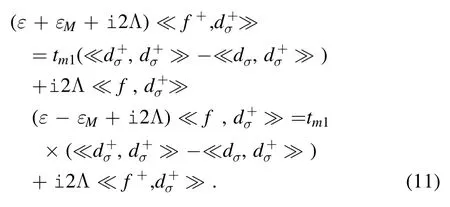
Substituting the above equations into equation (10),we can derive the follow equation




We first plot the DOS under different QD energy level εdσin figure 2.The anti-resonance structure of the DOS forms around ε=0 no matter how εdσchanges.The DOS shows bimodal symmetric structure when εdσ=0.However it changes to bimodal asymmetric structure when εdσ≠0,and one of the peaks moves to the lower energy level as the increase of εdσ.From the analytical process by solving the central Hamiltonian of the QD-CMBS part of the system [28],the position relationship between the double peak of the DOS will be simplified as the four energy eigenvalues aswhereWhen εdσ≠0,the DOS has a dip structure,and two resonance structures will be symmetrically distributed on both sides.On the other hand,the DOS will exhibit an asymmetric structure if εdσ≠0.The resonance position of DOS shifts,therefore an asymmetric resonance structure appears.The amplitude of the DOS decreases as the increase of εdσ,but the height of the peak does not drop.In the case of the special values of εMand tm1,the selfadjoint behavior of Majorana fermions results in the characteristic of DOS,which is a remarkable signature of the presence of the Majorana zero mode leaking into the lead and the QD [29].The Majorana operators are self-adjoint,namelyand thus they represent mixtures of particle and hole states,the interplay is manifested in the QD energy,which will destroy the symmetry property.When the QD energy level changes from εdσ=−3.5 to εdσ=2,the interaction and the Majorana zero energy modes change,as shown in the asymmetrical-symmetrical-asymmetrical transition in the DOS.The DOS properties show different behaviors for these two different situations,based on which one can distinguish the whether there are MBSs in this system.It should be noted that we chose tm1and Λ without any changing values on the DOS and linear conductance.They don’t change much when we choose other tm1and Λ,which is enough to describe the Kondo–Majorana transport of the system.
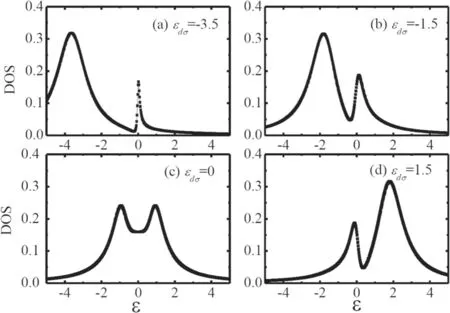
Figure 2.The DOS under different QD energy level εdσ,in the non-interaction case (U=0),the other parameters are chosen as follows:εM=0.05;p=0; tm1=Λ=0.5.
Next,we show the up- and down-spin DOS under different spin polarization strength in figure 3.In general,the upspin DOS (figure 3(a)) increases with the increase of p.The up-spin DOS around zero energy increases and it exhibits the reversal process from an anti-resonance to resonance when p changes from p=0 to p >0.3.With the further increase of p,it presents a more obvious peak structure(p=0.9).The peak structure also increases with the increase of the p.However,the down-spin DOS decreases with the increase of p as seen from figure 3(b).The down-spin DOS around zero energy also decreases with the increase of p.According to the definition of p,the effective coupling coefficient determines whether the DOS increases or decreases.For the up-spin DOS,increases (decreases) with the increase of p,so the up-spin(down-spin)DOS increases with the increase of p.We can conclude that the up-(down-spin)resonance deceases with the increase of p.On the other hand,p does not only increase the up-spin DOS resonance but also shifts its peak position.This consideration clarifies why we have encountered the different up-and down-spin p dependence of the DOS.Note that the value of the down-spin DOS is smaller than that of the up-spin DOS,which is in accordance with the asymmetry hybridization between the up-spin and downspins.Namely,determines that the up-spin (downspin) DOS increases (decreases) with the increasing p.From the perspective of up- and down-spin value of the DOS in figure 3,we can also conclude that the up-spin is obviously beneficial to the total DOS.We hope to control the specific spin manipulation in the real experiment,which can be realized by controlling the up-spin state.
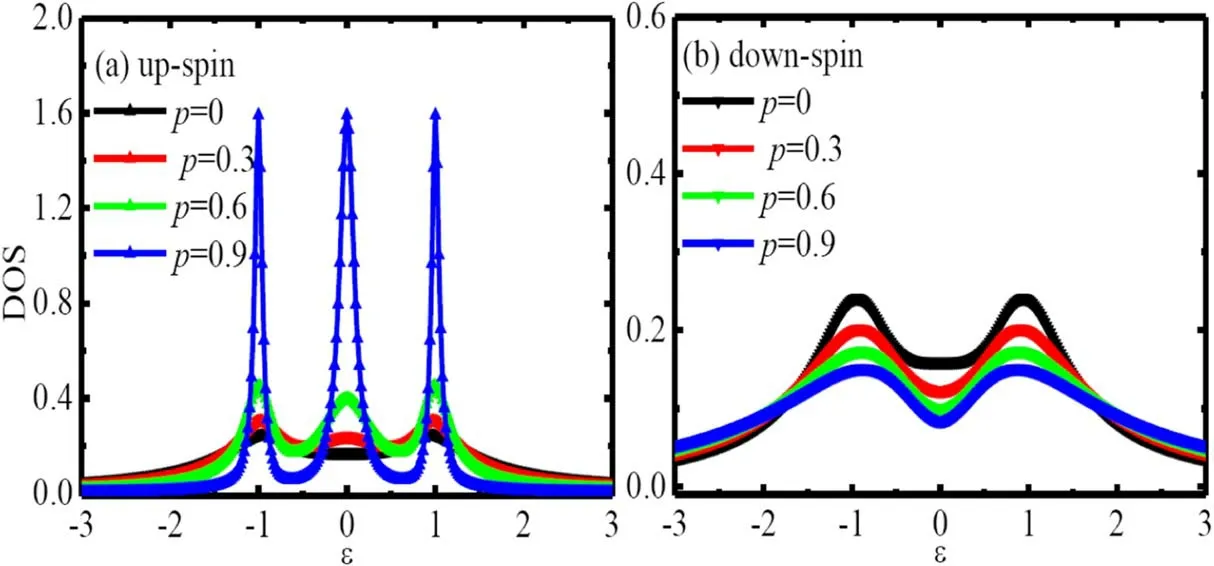
Figure 3.The up-and down-spin DOS with different spin polarization strength p in the non-interaction case,εdσ=0 and the other parameters are chosen the same as that in figure 2.

Figure 4.The up- and down-spin linear conductance as a function of spin polarization strength under different QD energy level,the other parameters are chosen the same as that in figure 2.
In order to clearly show the p and εdσdependence on the DOS,we plot the up-and down-spin linear conductance as a function of the p under different εdσin figure 4.The value of the up-spin linear conductance (figure 4(a)) is obviously larger than that of the down-spin linear conductance(figure 4(b)),which has the same properties as that shown in the DOS in figure 3.From this perspective,the up-spin conductance mainly contributes the total conductance passing through in the system.Specifically,the up-spin conductance shows an obvious increasing trend with the increase of p(p >0.4).There is little difference between the value change of the conductance and the energy level of εdσwhen p <0.4.This is why the up-spin DOS (figure 3(a)) does not change much in the small p.We see an obvious conductivity increasing trend when the value of p is large(p >0.4),which can also explain why the up-spin DOS show a transition from an anti-resonant structure to a resonant structure in figure 3(a)(p=0.9).Correspondingly,we see that the down-spin conductance linearly decreases with the increase of p,which can be used to explain the sequential decrease in the DOS near zero energy level.When p is comparable large (p ≥0.6),the up-spin conductance increases fast when εdσis small.Under the same spin polarization strength,we see that the conductance value is always at maximum when εdσ=0 in contrasting to the case of εdσ=−3.5.For the fully polarized case with p=1,the down-spin conductance will vanish in the present case in contrast to the up-spin.Through the further description of total linear conductance in figure 4(c),we see that the similarity between total linear conductance and the up-spin linear conductance.This is consistent with that shown in figure 3 where the up-spin contributes the main part of the DOS.The linear conductance does not change much when p <0.4,and with the further increase of p.When p >0.4,the increase of linear conductance under different is obvious.The conductance value at εdσ=0 is the largest whether it is upspin or down-spin.As the absolute value of increases,the linear conductance decreases,even we cannot see the linear conductance value when εdσ=−3.5.On the other hand,the conductance is mainly contributed by up-spin electrons in the large p region.
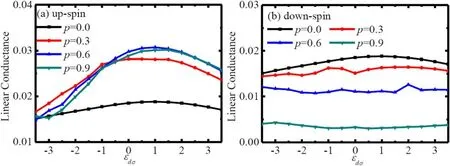
Figure 5.The linear conductance as a function of εdσ under different spin polarization strength in the infinite interaction case(U →∞),the other parameters are chosen as follows: εM=0.05;tm1=Λ=0.5.
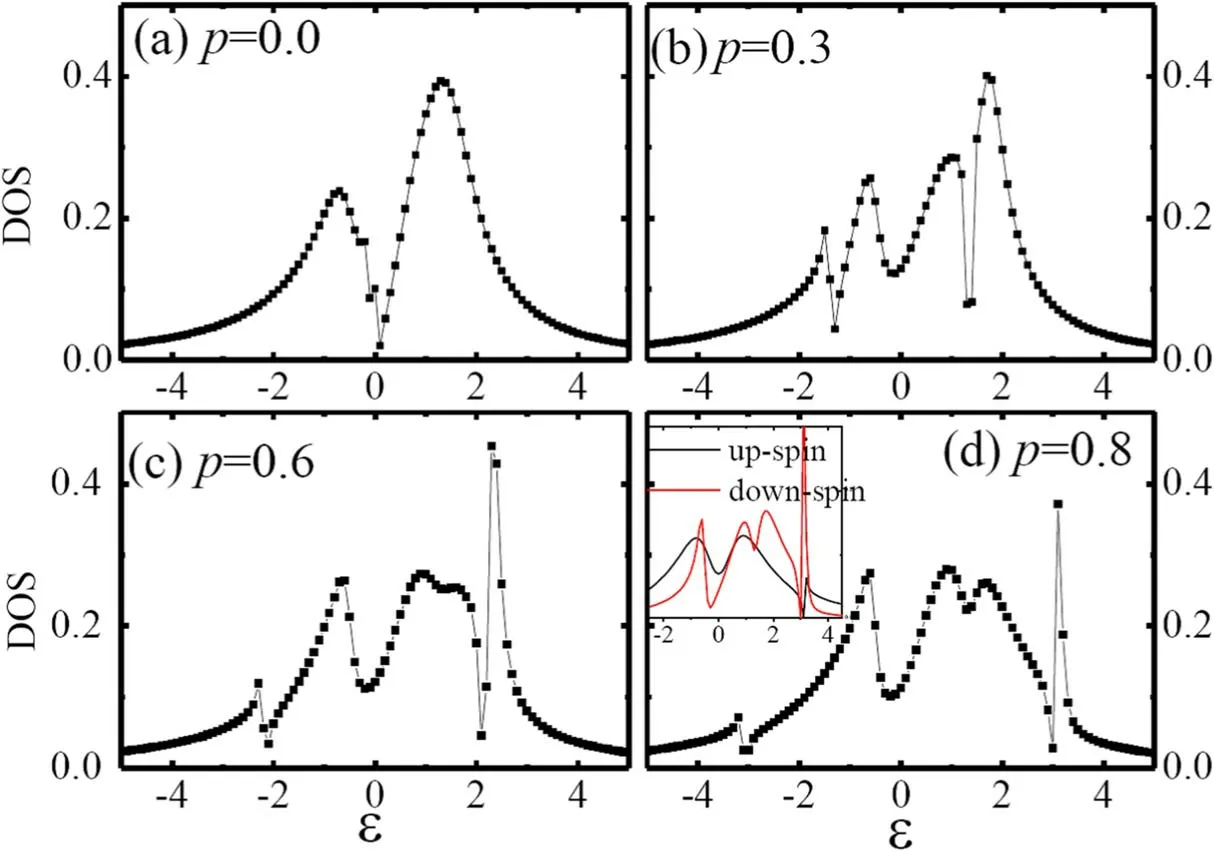
Figure 6.The total DOS under different spin polarization strength,the inset of(d)shows the explicit up-and down-spin DOS under large spin polarization strength (εdσ=0,p=0.8).The other parameters are chosen the same as that in figure 5.
In this subsection we study the infinite interacting regime of the QD (U →∞).In contrast to the previous subsection,we should emphasize that,the Green's function for spin σ determines on QD occupation nσgiven byImWe describe the properties of the linear conductance changing with εdσof the system.From the specific up- and down-spin linear conductance in figure 5,the linear conductance under zero spin polarization is obviously different from the linear conductance under non-zero spin polarization with the change of εdσ.Although it increases with εdσ,the increase rate at non-zero is significantly greater than that at the zero case.And the linear conductance get the maximum near εdσ=1,however,it tends to weaken with the further increase of εdσcorrespondingly.With the introduction of the spin-polarization,the renormalized energy level of the QD causes an enhanced effect with the increase of p,but this enhancement will be restrained by the QD-MBS coupling.Also,it can be used to extract the important parameters of the Majorana's mutual interaction and its coupling to the lead.But the down-spin linear conductance does not change so much.Although it shows a weakening trend with the increase of p,it is smaller than the up-spin hybridization.With the change of εdσ,the dependence of p on the value of linear conductance is not obvious,namely,it shows a relatively equilibrium distribution when p changes from p=0 to p=0.9.Finally,the linear conductivity change rate is almost closing zero especially when p is relatively large (p=0.9).
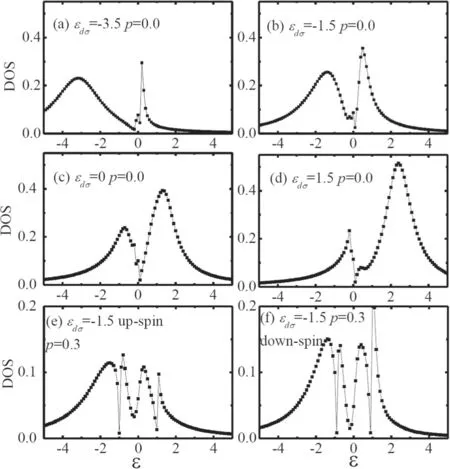
Figure 7.The total DOS under different QD energy level εdσ,in the infinite case(U →∞),the other parameters are chosen the same as that in figure 5.
We plot the total DOS dependence on the spin polarization strength in figure 6.The notch structure of the DOS around εdσ=0 will not change with the change of p.The Kondo resonance is located at energies coinciding with the renormalized energy of the QD.The renormalized calculation of the QD energy level causes its initial energy shifting because of the introduction of infinite interaction strength [30],where the real part of the denominator of η3and η4is found self-consistently from the relationThus in the absence of spin polarization,the Kondo resonances is located on both sides of the Fermi levelFrom figure 6(a),we cannot see the DOS resonance splits when p=0.However,the Kondo peak splits when p ≠0,giving rise to two sub-Kondo peaks.The splitting of the resonance peak structure is found at p=0.3,0.6,0.8 because of the spin-dependent DOS in the leads.The hybridization is spin dependent,which is due to the splitting of the dot levels renormalized by the spin-dependent interacting self-energyIn other words when the spin polarization is applied,the Kondo peak splits into two located peaks.We note that the Kondo resonances will appear at different positions without this self-consistency relation.The procedure simulates higher-order contributions of the dot-level on spin fluctuations.The introduction of p will not cause a change in the dip of the DOS,but it can cause the Kondo split on both sides of εdσ=0.For the case of spin-polarized lead,the electronlead interactions can induce a different occupation number(n↑≠n↓) of the renormalized QD level which give rise to the exchange interaction in the ferromagnetic lead.Namely,the spin dependent hybridization causes the spin dependent occupancy number to decrease as p increases (n↑>n↓),so the DOS will inevitably split with the increase of p.This weakening is more obvious for the down-spin DOS.We find that due to the energy split caused by the polarization,the down-spin DOS splits again compared with that in the up-spin DOS in the inset of figure 6(d).For comparing,we present the DOS at εdσ=−3.5,−1.5,0,1.5 for U →∞in figures 7(a)–(d).We see that a more obvious dip structure with the change of energy level εdσ.Such a peak transition still exists,which is the same as the peak transition as shown in figure 2.Therefore,we can conclude that such a relationship is sufficient to show the importance of the coupling relationship between Majorana and QDs.Unlike the case of U=0,there is no bimodal symmetric structure when εdσ=0.And this obviously comes from the renormalization of the QD energy level.As a comparison,we plot a specific DOS distribution in the case of εdσ=−1.5 (figures 7(c) and (d)).Both the up-spin and down-spin DOS split with the change of p.Obviously,this split is consistent with that in figure 6.It should be noted that the introduction of the spin polarization leads to the renormalization distribution of the QD energy level,which leads to the difference in the up-and down-spin DOS.The down-spin peak is larger than the down-spin peak,however,they have the same split location.The contribution of ferromagnetic leads is to enhance the Kondo peak of the DOS.
In summary,we have analyzed the spin-dependent Majorana–Kondo interplay of a QD-Majorana wire system.We have studied the behavior of the DOS and the linear conductance dependence on the dot-level and spin polarization strength of the lead.We demonstrated that the DOS resonance shifts with the change of energy level.The linear conductance show different characteristics for up-and downspin directions characteristics under the spin polarized situation.Besides,the DOS shows a splitting behavior in the higher energy level with the increase of spin polarization strength.Our results reveal that the transport originates from the interplay between the Kondo correlations and the coupling to the topological Majorana wire.In this regard,the results presented in this paper may be applied to the spin-dependent hybrid Majorana-dot devices.
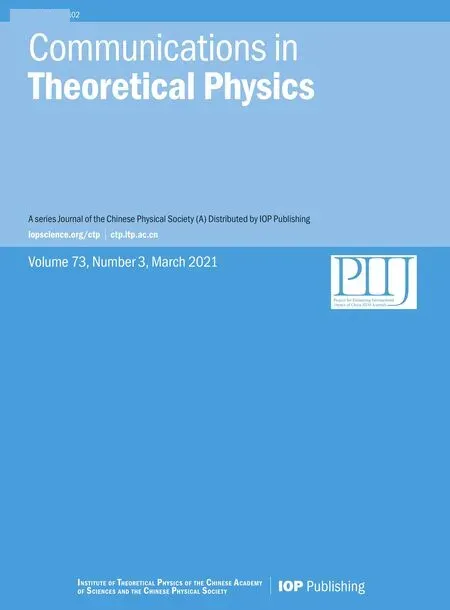 Communications in Theoretical Physics2021年3期
Communications in Theoretical Physics2021年3期
- Communications in Theoretical Physics的其它文章
- A new approach for modelling the damped Helmholtz oscillator: applications to plasma physics and electronic circuits
- Analysis of the excited Ωc states as the pentaquark states with QCD sum rules
- Investigation of quark distributions in a family of pentaquarks using the Thomas–Fermi quark model
- Coexistence and fluctuations phenomena with Davidson-like potentials in quadrupole–octupole deformed nuclei
- Effect of Zn doping on electronic structure and optical properties zincblende GaN (A DFT+U insight)
- First-principles study on superconductive properties of compressive strain-engineered cryogenic superconducting heavy metal lead (Pb)
